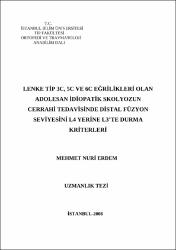| dc.contributor.advisor | Kara, Ayhan Nedim | en_US |
| dc.contributor.author | Erdem, Mehmet Nuri | |
| dc.date.accessioned | 2014-06-27T07:40:21Z | |
| dc.date.available | 2014-06-27T07:40:21Z | |
| dc.date.issued | 2008 | |
| dc.date.submitted | 2008 | |
| dc.identifier.citation | Erdem, Mehmet Nuri. (2008). Lenke Tip 3C, 5C Ve 6C Eğrilikleri Olan Adolesan İdiopatik Skolyozun Cerrahi Tedavisinde Distal Füzyon Seviyesini L4 Yerine L3’te Durma Kriterleri. Yayımlanmamış doktora tezi. İstanbul : İstanbul Bilim Üniversitesi, Tıp Fakültesi. | en_US |
| dc.identifier.uri | https://hdl.handle.net/11446/201 | en_US |
| dc.description | İstanbul Bilim Üniversitesi, Tıp Fakültesi, Ortopedi ve Travmatoloji Anabilim Dalı | en_US |
| dc.description.abstract | İdiopatik skolyoz tanısı konan bir hastada cerrahi tedavi kararı alındıktan sonra önemli olan nokta spinal füzyon yapılacak sahanın belirlenmesidir. İdeal olarak füzyonun distal ucu lomber hareketli segmentlerin korunması için mümkün olduğunca proksimalde ve gövde imbalansına yol açmayacak kadar distalde olmalıdır. Özellikle çift major veya major torakolomber/lomber (TL/L) eğriliklerde olduğu gibi enstrümentasyonun hem torasik hem lomber eğriliği içermesi gereken durumlarda füzyonun distalde genellikle L4 çok nadir olarak da L3 seviyesinde durması gereklidir. L3 ile L4 arasındaki seçim zorluk teşkil etmektedir. Spinal denge füzyon (enstrümentasyon) distalde stabil vertebrayı içerdiği zaman elde edilebilmektedir. Bu çalışmanın amacı Lenke 3C, 5C and 6C eğriliklerde L3 santral sakral vertikal çizgi (CSVL)’ye dokunmasa bile füzyonu L4 yerine L3’te sonlandırmakta kullanılacak preoperatif radyolojik kriterlerin belirlenmesidir.
Bu çalışma 2002 ile 2007 yılları arasında tek bir merkezde adolesan idipatik skolyoz tanısı ile opere edilen 140 hastadan en az 2 yıllık takibi olan 118 hasta dahil edilerek yapıldı. Çalışmaya Lenke tip 3C, 5C and 6C eğriliği olan ve posterior spinal füzyon uygulanan adelosdan idiopatik skolyozlu hastalar alındı. 118 hastanın ortalama takip süresi 42 (24-60) ay, ortalama yaş 15.4 (13-18) yıl idi. Tüm hastalarda füzyon distalde L3 seviyesinde durduruldu.
Bu çalışmada; hastaların üçte birinde CSVL L3’e temas etmemekte iken bending ve traksiyon grafileri ve özellikle genel anestezi altında çekilen traksiyon (GAAT) grafisinde L3’ün pelvise paralel hale geldiği görüldü. Bu hastalarda füzyonu distalde L3’te durdurmak mümkündür. Hastaların üçte ikisinde ise CSVL L3’e temas etmediği gibi bending grafilerde de L3’ün pelvise parallel olmadığı görüldü. Genel anestezi altında çekilen traksiyon grafileri özellikle bu hastalarda faydalı oldu çünkü L3’ün pelvise paralel hale geldiği, CSVL’nin L3’e temas ettiği veya kestiği ve L3’ün büyük oranda Harrington’un stabil zonu (HSZ) içinde kaldığı tespit edildi. Bu sebeple bu hastalarda distalde füzyon seviyesi bending grafilere bakarak L3 vertebrada sonlandırılamazken, GAAT grafisi ile somlandırılabileceği görülmüştür. Bu bulgular bizi bu hasta grubunda füzyonun L4 yerine L3’te durmaya teşvik etmiştir. Böylece vertebral kolonun dengesini bozmadan daha fazla hareketli segmenti korumak mümkün olabilmiştir. | en_US |
| dc.description.abstract | Important decision after determination of a patient requiring surgery for idiopathic scoliosis is the selection of the segments of the spine for fusion. Ideally, the distal extent of the fusion should be as proximal as possible to preserve lumbar motion segments, yet long enough to avoid creating trunk imbalance in the modern thinking about scoliosis surgery. When instrumentation of both the thoracic and the lumbar curves especially in double major or major thoracolumbar/lumbar (TL/L) curves (Lenke Type 3C, 5C and 6C or King Type I and IV) is required, the distal extention of fusion is usually L4 or rarely L3 level. Choosing between L3 and L4 can be difficult. The most predictable spinal balance occurs when the fusion/instrumentation extends distally to the stable vertebra. The purpose of this study is to determine preoperative radiological criteria to stop the fusion distally at L3 level instead of L4 in Lenke 3C, 5C and 6C curves even when CSVL does not touch L3.
This study reviewed 140 patients with adolescent idiopathic scoliosis surgically treated between 2002 and 2007 in a single institution and 118 of them were available for minimum 2-year follow-up evaluation. Included in the study were patients who underwent an instrumented posterior spinal fusion for adolescent idiopathic scoliosis with Lenke type 3C, 5C and 6C curves. For the 118 patients, the average follow-up period was 42 months, ranging from 24 to 60 years. The average age at surgery was 15.4 years, ranging from 13 to 18 years. Distal fusion was stopped at L3 in all patients.
In the current study; in nearly one third of our cases, CSVL does not touch L3 but L3 becomes level to pelvis at bending radiographs and traction radiographs, especially when taken under general anesthesia. It is possible to stop fusion at L3 in those cases. In two thirds of cases, CSVL does not touch L3 and it does not become level at bending radiographs. Traction radiographs taken under general anesthesia are especially helpful in these cases because L3 becomes level, CSVL touches or bisects L3 and L3 is completely in Harrington’s stable zone. Thus, according to bending radiographs you can not stop at L3 but you can do so according to traction radiographs taken under general anesthesia. These findings encouraged us to stop the fusion distally at L3 level instead of L4. Thus, it is possible to save more motion segments distally without unbalancing the vertebral column. | en_US |
| dc.language.iso | tur | en_US |
| dc.publisher | İstanbul Bilim Üniversitesi, Tıp Fakültesi. | en_US |
| dc.rights | info:eu-repo/semantics/openAccess | en_US |
| dc.subject | skolyoz | en_US |
| dc.subject | scoliosis | en_US |
| dc.title | Lenke tip 3C, 5C ve 6C eğrilikleri olan adolesan idiopatik skolyozun cerrahi tedavisinde distal füzyon seviyesini L4 yerine L3’te durma kriterleri | en_US |
| dc.title.alternative | Can we stop fusion distally at L3 instead of L4 vertebra in the surgical treatment of adolescent idiopathic scoliosis with lenke type 3C, 5C and 6C curves | en_US |
| dc.type | doctoralThesis | en_US |
| dc.department | DBÜ, Tıp Fakültesi | en_US |
| dc.relation.publicationcategory | Tez | en_US |


















